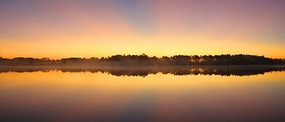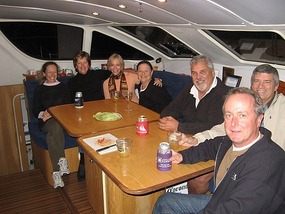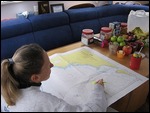Throughout the summer of 2011 we had been planning to winter again in the Eastern Caribbean, but planned not to travel as far south nor move around quite as much as our initial "reconnaissance" cruise there in the winter of 2010-2011. Regardless of where we would travel about once we had arrived, what dominates our preparations now is the offshore passage from the Chesapeake Bay direct to first landfall in the U.S. or British Virgin Islands.
In the big picture, the offshore passage preparations mean getting the boat, crew, and provisions ready for 7 to 10 days at sea in time to depart near the end of hurricane season in early November, then picking a favorable weather window as near term forecasts become available. The specific departure has to be “not too soon, but not too late.” The scheduling dilemma that develops is that the longer into November we wait, the less likelihood a late season tropical weather system may develop in our path (read: hurricane—the season doesn't officially end until November 30); however delaying too far into November leads to more likelihood of severe cold fronts developing off the North American continent and disturbing the weather to the extent that they make a lengthy passage uncomfortable to unsafe. As is quite common, the insurance coverage of Pas de Deux requires we stay north of the latitude of Jacksonville, FL until November 1, so early in our planning we intended to be ready to depart as early as October 30 knowing it would take multiple days to travel that far south.
Once again this year we subscribed to a weather router’s service (Chris Parker’s Caribbean Weather Center) with whom we interface over the SSB radio while cruising. We begin this interaction approximately one week before our targeted passage date so as to try to identify a good weather window for our departure that ideally will last through the length of the journey. In reality, forecasts become unreliable beyond about 4 days, so we continue to communicate daily once underway. Once we have arrived at our destination, we listen in to forecasts as necessary for the region we are in, especially if we have no local VHF radio source for local weather information.
Our planning included leaving Pas de Deux “on the hard” (out of the water) at Jaynes Marine in Reedville until about 3 days prior to our earliest possible departure date (October 27) in order to maximize the amount of time Dave would have to prepare the boat for launching, and for Donna to finish preparing passage and 7 months of cruising provisions at home in Arlington. Included in this timing was coordinating crewmember Bob’s arrival back to Jaynes from Ontario and affording him as much time as possible to finish some projects on sister ship Our White Magic which was also hauled there. More of the 3-day choreography after getting the boat launched would involve transporting Donna and the remainder of our provisions from Arlington (the boat has to be in the water for refrigeration to work), jockeying automobiles so that Dave’s car (and Bob) would end up at crew Wally’s house in Virginia Beach and Bob’s truck would end up at our home in Arlington for his return flight into Reagan National Airport, and sailing the boat to Norfolk to get fuel and pick up Bob and Wally just prior to departing the Chesapeake. That was the plan, anyway...
By October 23rd we could tell that long range forecasts would not support an Oct. 30th departure. Conditions favorable for development of a LO pressure system were coming together in the Atlantic south of Bermuda. So launching Pas de Deux was delayed until Oct. 30th. Hoping for the best, from that point we implemented the provisioning, car jockeying, and moving to Norfolk choreography for a newly targeted departure on November 2. That was the plan, anyway….
After the launching on October 30, Dave and Bob drove to Arlington the following day in Bob’s truck. Donna had already begun loading the last of our provisions into Dave’s car. We drove back to Jaynes that same day in Dave’s car, with coolers overflowing onto the roof, leaving Bob’s truck in Arlington. With much appreciated help from other cruisers at Jaynes, we loaded the provisions bucket-brigade style aboard Pas de Deux just before dusk. Dave and Donna departed Jaynes for Norfolk the next morning of November 1, stopping by Hampton for diesel fuel before anchoring in Willoughby Bay after dark. That same day, Bob drove Dave’s car to Wally’s house in Virginia Beach. All was ready for departure very late the following day. That was the plan, anyway….
After listening to the morning weather reporting November 2, we all agreed that we should delay the departure indefinitely until the LO pressure system that did indeed develop (and unfortunately was lingering for quite some time) decided where it was going and when. Realizing we probably had to wait multiple days, Dave and Donna sailed Pas de Deux back up the Bay a short distance the next day. This would provide a more pleasant anchorage in Mobjack Bay to wait out the rough weather that would affect Norfolk from the movement of what had become the named storm “Sean”. Bob drove back to Jaynes to do more work on his boat. Wally had to go back to (real) work.
Finally, five days later on November 8, after it was clear Sean would pass well offshore, Dave and Donna sailed the boat back to Norfolk and docked in Willoughby Harbor Marina for a night with a plan to take long hot showers, board Bob and Wally, and depart late the next day. Several well-wishing friends stopped by the boat with drinks for a final farewell. Finessing the weather analysis a bit more, the “next day” became the day after that. Finally, the weather fell into place and we devised a departure behind a passing cold front on strong NNW winds around midnight of November 10, slipping out of the Chesapeake on a falling tide and getting to the Gulf Stream off Cape Hatteras during daylight the next day.
This was another example of “not too soon, but not too late” timing. The winds ahead of the cold front were very strong from the NE and offshore seas were very rough from Sean. Just behind the front, expected to arrive late in the evening, the winds were forecast to back to the NNW – allowing seas to moderate - and subside by the time we reached the Gulf Stream crossing point east of Cape Hatteras. The front arrived and passed as expected – identified by the backing wind - and we left the dock at 0008 EST on Friday November 11. Dave reminded everyone of the age old seafaring superstition that it was bad luck to begin a voyage on a Friday (where does he get this stuff???!!!). Regardless, since we actually began removing our dock lines minutes before midnight and also could consider that the “voyage” began days ago when we left Mobjack Bay (heck –even when we left Jaynes!), everyone was comfortable that King Neptune would give us a pass…..
Preparations for 2011 Passage to Eastern Caribbean
Thursday, November 10, 2011
 Reedville, Virginia, United States
Reedville, Virginia, United States
Other Entries
-
157The Morning After the Night Before
Feb 27256 days prior Simpson Bay, Saint Martinphoto_camera4videocam 0comment 0
Simpson Bay, Saint Martinphoto_camera4videocam 0comment 0 -
158Next stop – Virgin Gorda, BVI
Feb 28255 days prior North Sound, Virgin Islands Britishphoto_camera18videocam 0comment 0
North Sound, Virgin Islands Britishphoto_camera18videocam 0comment 0 -
159Touring BVI with Wally and Larry
Mar 03252 days prior Anegada, Virgin Islands Britishphoto_camera31videocam 0comment 0
Anegada, Virgin Islands Britishphoto_camera31videocam 0comment 0 -
160Return to North Gorda Sound
Mar 06249 days prior Trellis Bay, Virgin Islands Britishphoto_camera1videocam 0comment 0
Trellis Bay, Virgin Islands Britishphoto_camera1videocam 0comment 0 -
161It Ain’t All Rum and Mangoes
Mar 22233 days prior Soper's Hole, Virgin Islands USphoto_camera1videocam 0comment 0
Soper's Hole, Virgin Islands USphoto_camera1videocam 0comment 0 -
162National Park Highlights on St John, USVI
Mar 23232 days prior Caneel Bay, Virgin Islands USphoto_camera1videocam 0comment 0
Caneel Bay, Virgin Islands USphoto_camera1videocam 0comment 0 -
163The Definition of Cruising
Apr 03221 days prior Charlotte Amalie, Virgin Islands USphoto_camera1videocam 0comment 0
Charlotte Amalie, Virgin Islands USphoto_camera1videocam 0comment 0 -
164Another Group of Virgins
Apr 23201 days prior Cayo de Luis Pena, Puerto Ricophoto_camera20videocam 1comment 0
Cayo de Luis Pena, Puerto Ricophoto_camera20videocam 1comment 0 -
165Passage to the Turks and Caicos Islands
Apr 27197 days prior French Cay, Turks and Caicosphoto_camera12videocam 1comment 0
French Cay, Turks and Caicosphoto_camera12videocam 1comment 0 -
166Overnight Passage to the Bahamas
May 01193 days prior Salina Point, Bahamasphoto_camera8videocam 2comment 0
Salina Point, Bahamasphoto_camera8videocam 2comment 0 -
167Passage Through the Jumentos and Hog Cay Cut
May 05189 days prior Hog Cay Cut, Bahamasphoto_camera5videocam 0comment 0
Hog Cay Cut, Bahamasphoto_camera5videocam 0comment 0 -
168Transiting from the Exuma Sound to the Exuma Bank
May 09185 days prior Highborne Cay, Bahamasphoto_camera17videocam 2comment 0
Highborne Cay, Bahamasphoto_camera17videocam 2comment 0 -
169Northward to the Berry Islands
May 16178 days prior Great Harbour Cay, Bahamasphoto_camera7videocam 0comment 0
Great Harbour Cay, Bahamasphoto_camera7videocam 0comment 0 -
170To Sail or Not to Sail
May 23171 days prior Palm Beach, United Statesphoto_camera3videocam 0comment 0
Palm Beach, United Statesphoto_camera3videocam 0comment 0 -
171Homeward Bound
May 30164 days prior Willoughby Harbor Marina, United Statesphoto_camera8videocam 0comment 0
Willoughby Harbor Marina, United Statesphoto_camera8videocam 0comment 0 -
172Hobie Fleet 32 Day Sail
Jul 03130 days prior Willoughby Harbor Marina, United Statesphoto_camera11videocam 0comment 0
Willoughby Harbor Marina, United Statesphoto_camera11videocam 0comment 0 -
1732011 Summer Maintenance
Nov 019 days prior Reedville, United Statesphoto_camera10videocam 0comment 0
Reedville, United Statesphoto_camera10videocam 0comment 0 -
174Preparations for 2011 Passage to Eastern Caribbean
Nov 10 Reedville, United Statesphoto_camera4videocam 0comment 0
Reedville, United Statesphoto_camera4videocam 0comment 0 -
175First 3 Days of Passage Norfolk to Virgin Islands
Nov 133 days later Somewhere in the Atlantic Ocean, Internationalphoto_camera8videocam 2comment 0
Somewhere in the Atlantic Ocean, Internationalphoto_camera8videocam 2comment 0 -
176Mild Conditions and the Mid-Ocean Swim -Days 4 + 5
Nov 155 days later Somewhere In The Atlantic Ocean, Internationalphoto_camera11videocam 1comment 0
Somewhere In The Atlantic Ocean, Internationalphoto_camera11videocam 1comment 0 -
177Our Progress Speeds Up – Days 6 and 7
Nov 177 days later Somewhere in Atlantic Ocean, Internationalphoto_camera1videocam 0comment 0
Somewhere in Atlantic Ocean, Internationalphoto_camera1videocam 0comment 0 -
178Targeting a Daylight Arrival –The Final Days
Nov 199 days later Soper's Hole, Virgin Islands USphoto_camera12videocam 0comment 0
Soper's Hole, Virgin Islands USphoto_camera12videocam 0comment 0 -
179Destination U.S. Virgin Islands with Wally and Bob
Nov 2313 days later Charlotte Amalie, Virgin Islands USphoto_camera17videocam 0comment 0
Charlotte Amalie, Virgin Islands USphoto_camera17videocam 0comment 0 -
180Settling Into Another Season in Paradise
Dec 0323 days later St Croix, Virgin Islands USphoto_camera25videocam 1comment 0
St Croix, Virgin Islands USphoto_camera25videocam 1comment 0 -
181Our Return to the Spanish Virgin Islands
Dec 1434 days later Culebra, Puerto Ricophoto_camera26videocam 1comment 0
Culebra, Puerto Ricophoto_camera26videocam 1comment 0 -
182Eastward Bound
Dec 1838 days later Charlotte Amalie, Virgin Islands USphoto_camera1videocam 0comment 0
Charlotte Amalie, Virgin Islands USphoto_camera1videocam 0comment 0 -
183Seeking New Destinations in the BVI
Dec 1939 days later Soper's Hole, Virgin Islands USphoto_camera0videocam 0comment 0
Soper's Hole, Virgin Islands USphoto_camera0videocam 0comment 0 -
184Exploring the Islands of Sir Francis Drake Channel
Dec 2646 days later Buck Island, Virgin Islands Britishphoto_camera15videocam 0comment 0
Buck Island, Virgin Islands Britishphoto_camera15videocam 0comment 0 -
185Exploring Virgin Gorda's North Sound
Jan 0758 days later Robin Bay, Virgin Islands Britishphoto_camera54videocam 7comment 0
Robin Bay, Virgin Islands Britishphoto_camera54videocam 7comment 0 -
186Moving Back Westward Through the BVI
Jan 1061 days later Valley Trunk Bay, Virgin Islands Britishphoto_camera11videocam 0comment 0
Valley Trunk Bay, Virgin Islands Britishphoto_camera11videocam 0comment 0 -
187Destination Little Jost Van Dyke
Jan 1162 days later Sandy Spit, Virgin Islands Britishphoto_camera7videocam 0comment 0
Sandy Spit, Virgin Islands Britishphoto_camera7videocam 0comment 0 -
188Great Expectations, Great Escapes
Jan 1263 days later Cane Garden Bay, Virgin Islands Britishphoto_camera1videocam 0comment 0
Cane Garden Bay, Virgin Islands Britishphoto_camera1videocam 0comment 0 -
189Final Winter Days in the British Virgin Islands
Jan 1566 days later Cane Garden Bay, Virgin Islands Britishphoto_camera5videocam 0comment 0
Cane Garden Bay, Virgin Islands Britishphoto_camera5videocam 0comment 0 -
190A Day in the Life
Jan 1667 days later Cruz Bay, Virgin Islands USphoto_camera0videocam 0comment 0
Cruz Bay, Virgin Islands USphoto_camera0videocam 0comment 0 -
191Short Visits with Friends Arriving in the Islands
Jan 2475 days later Crown Bay, Virgin Islands USphoto_camera15videocam 0comment 0
Crown Bay, Virgin Islands USphoto_camera15videocam 0comment 0 -
192Aiming for a Vacation to Remember
Feb 0385 days later Crown Bay, Virgin Islands USphoto_camera68videocam 6comment 0
Crown Bay, Virgin Islands USphoto_camera68videocam 6comment 0

 Reedville, Virginia, United States
Reedville, Virginia, United States











2025-05-23